Battleship
Drones: Desert Storm, Remotely Piloted Vehicles, and Joint Lessons for the 21st
Century Warfighters
By: Capt. Grant T. Willis, USAF | July 20th, 2025
PDF Version
Saddam Goes South
After
midnight on August 2nd, 1990, Ba’athist Dictator of Iraq, Saddam Hussein, sent
7 Divisions and 3 Separate Special Forces Brigades of his elite and politically
reliable Republican Guard into the Gulf Emirate of Kuwait. Iraq’s oil-rich neighbor had been accused by
Saddam of waging an economic war against Baghdad after its costly 8-year long
war with Iran had left it starved of cash.
In the summer of 1990, Iraq boasted one of the largest militaries in the
world with over 1,000,000 troops, more than 5,000 tanks, 3,500 + artillery
tubes, 6,000 armored personnel carriers, 600 + surface to air missile
launchers, 500 fixed wing aircraft, 500 rotary wing aircraft, and 44 naval
vessels.[1] As the few remaining units of Kuwait’s 2
mechanized brigades fled into Saudi Arabia, the international community and the
United States moved to form a coalition to throw Saddam out. Leading the Allied coalition at sea were not
only the powerful U.S. aircraft carriers, but an even more classic American
naval icon, the battleships. The last
use of the upgraded World War II-era Iowa Class Fast Battleships in combat and
their often-forgotten role in the development of unmanned combat aviation
showcase innovations that can inspire today’s joint minded practitioners of
war. The use of drones from battleships in Operation Desert Storm highlights
many takeaways and lessons learned for both regular and irregular joint forces
in today’s Department of Defense (DOD).
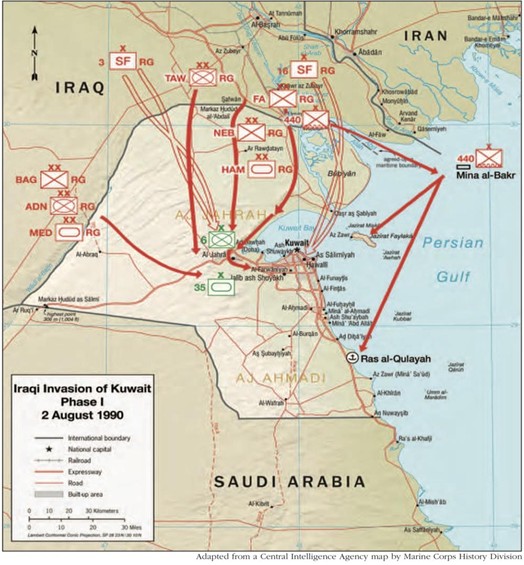
Today,
to support the conventional force, Special Operations Forces (SOF) must
complicate the enemy’s thinking and create “dilemmas” an enemy command
structure must attempt to mitigate.
SOF’s ability to use unique joint capabilities to instill “dilemmas” in
the enemy’s battle plan fix forces out of position and enable our joint
conventional force freedom of action.
There are many SOF examples of this concept which are well known, such
as the Air Force Special Operations Command (AFSOC) operations leading Task
Force Normandy to take out Iraqi Early Warning Radar sites during Operation
Desert Storm and the so called “Ugly Baby” mission to insert U.S. Special
Forces into Northern Iraq in Operation Iraqi Freedom, leading to the fix of 13
of Saddam’s 20 divisions north of Baghdad.
There is much to learn from such operations and there is plenty of
material available to appreciate the lessons associated with them; however,
some tactical actions like the use of drones from battleships can serve a
similar form of instruction for SOF air professionals.
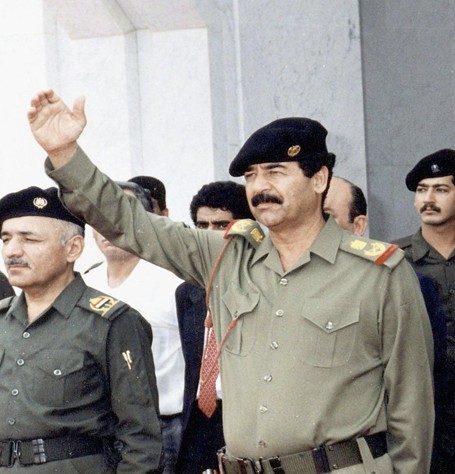
Israeli Drones Inspire the DOD
In
1982, the Israeli Air Force (IAF) utilized aerial drones to spot and spoof
Syrian air defense batteries in Lebanon’s Bekaa Valley. The Israeli “Scout” drones flying above the
Valley, found and fixed Syrian mobile SA-6 “Gainful” surface to air missiles
(SAM), ZSU-23-4 “Shilka” air defense artillery (ADA) and accompanying radar
sites. These drones, on top of identifying enemy positions, got the Syrians to
foolishly turn on their radars, exposing them to attack from IAF high-speed anti-radiation
missiles (HARMs). Those Syrian batteries
not destroyed by HARMs were cleaned up by other IAF strike aircraft dropping
bombs and firing rockets. Only 2 out
of the 17 Syrian SAM sites in the Bekaa Valley survived destruction.[2] The United States Navy took note of the
Israeli innovation in the use of air power and by the late 1980s, a contract
was finalized to provide aerial scout drone capabilities to the Department of
Defense. The American version of the Israeli Scout was known as the “Pioneer”
or “RPV” (Remotely Piloted Vehicle) and would be used as a new “eye in the sky”
for America’s reinvigorated battleships.[3]

Iowa Class Battleships & The Tomahawk
By
the early 80s, the Soviet fleet possessed 4 nuclear powered Kirov class
cruisers. In the West, their power
equated to many experts referring to them as “Battlecruisers”, therefore, the 4
Iowa Class Fast Battleships were brought back into the fleet as America’s
answer. Although old, the Iowa Class would bring
back their long-range heavy armament of 9 16-inch guns with a 23 miles range
plus some late Cold War upgrades.[4]
The
newest upgrade to the firepower of the recommissioned Iowa Class Fast
Battleships was the BGM-109 “Tomahawk” land attack missile (TLAM) housed in 8
Mark 143 “Armored Box” Launchers with 4 TLAMs each. The ships also received 16
RGM-84 “Harpoon” Anti-ship cruise missiles (ASCM) housed in 4 quad-cell mark
141 canisters. For anti-air
capabilities, they were equipped with a close-in weapons system (CIWS) in the
form of 4 mark 16 “Phalanx” 20-mm Gatling gun mounts capable of firing 50
rounds per second or 3,000 rounds a minute.
The Tomahawks extended the battleships’ main gun’s weapon engagement
range by 1,500 nautical miles. This
precision guided weapons system gave America’s battleships the range to hit the
heart of Saddam’s regime, Baghdad.[5] Both USS
Missouri and USS Wisconsin fired
their Tomahawks as part of the first BGM-109 strikes in combat against Iraqi
targets. Wisconsin served as TLAM strike commander in the Persian Gulf.
In
addition to the added firepower, the Battleships possessed a helicopter landing
deck complete with a detachment to operate the Navy’s latest Seahawk helicopter,
and a complement of deck launched and net recoverable remotely piloted vehicles
(RPVs). Known as the RQ-2 “pioneer”,
Navy Composite Squadron 6 (VC-6) would deploy units for Operation Desert Storm,
separating into 2 ship-borne detachments with Det 1 aboard USS Missouri
and DET 2 aboard USS Wisconsin. Similar
to the role of airborne gunfire spotting and aerial reconnaissance played by
the Vought OS2U “Kingfisher” catapult launched scout plane flying from
battleships during World War II, the Navy’s RPVs would be able to fill this
role while beaming back real time battlefield footage to the combat information
center (CIC). As the Missouri and
Wisconsin opened fire against Iraqi coastal targets in Desert Storm,
VC-6 would perform the task that many naval aviators assigned as spotting
aircrew did during WWII, but without the risk of losing a human life if the
aircraft were to be lost on target.
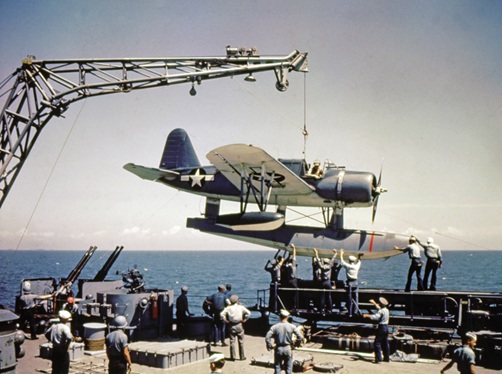
Bringing the Storm (Remotely)
After
the fall of the Soviet Union, the U.S. Navy again decommissioned the Iowa Class
Battleships beginning with Iowa in October 1990, followed by New Jersey in
February 1991. For Desert Storm, only Missouri
and Wisconsin remained to showcase their awesome firepower against
another challenger to America in the 20th century.
At
0140 hours on January 17th, 1991, Wisconsin,
as TLAM Strike Commander, coordinated the launch of 47 Tomahawk cruise missiles
from ships of the Fleet in the Persian Gulf.
Their targets, downtown Baghdad.
In conjunction with the Air Force’s new F-117 “Nighthawk” stealth
fighters and their precision guided bombs, Wisconsin
launched 8 TLAMs while Missouri
launched 7, joining the initial strikes to cripple strategic air defense and
command and control targets in Saddam’s capital. The battleships fired their missiles against
the enemy capital at a range of 330 miles.[6] The opening carrier battles of WWII in the
Pacific had shown the fact that the range of battleships was outmatched by the
striking power of the aircraft, but now, the battleship was back in the long-range
game, and the targets were downtown.
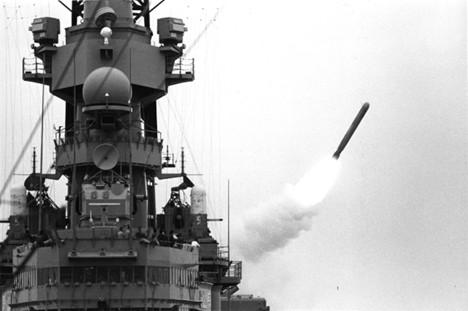
The
following night, both battleships fired an additional 29 Tomahawks. In total, Wisconsin coordinated the
launch of 213 Tomahawks while Missouri led coordination for naval
gunfire support (NGFS) to coalition ground units moving against the Iraqi Army
in occupied Kuwait. The Mighty MO’s 16-inch
guns first fired in anger against Iraqi coastal command bunkers on February
3rd. Missouri’s gunfire
throughout the campaign would be corrected in real time by the RQ-2s of VC-6.
Launched by rocket assistance from the battleship’s fantail, the Pioneer drones
flew line of sight only, limiting their range; however, in 1991 this capability
was revolutionary for real time video correction of fire through using their
infrared imaging. They could find and
fix targets for destruction by either the guns of the battleships or ground
artillery and air strikes.[7]
On
February 24th, Missouri, to deceive Iraqi leadership into believing a
coalition amphibious assault was imminent, began shelling occupied Faylakah Island.
This shore bombardment commenced prior to the Coalition assault into
Kuwait and U.S. 7th Corps’ famous “Left Hook” advance into Iraq to cut off
Saddam’s Army in Kuwait. Faylakah Island would be defended by 10 Iraqi Divisions!
Many of these units became intimately familiar with the consequences of being
on the working end of Missouri’s 133 16-inch shells throughout the
island’s bombardment and that naval gunfire’s accuracy was only made more
effective with the humming of the Pioneers loitering above.[8] To put Missouri’s gunfire into
perspective it is important to understand that one nine-gun salvo of 16-inch
guns off an Iowa Class battleship equates to the destructive power of 183 155mm
artillery pieces.
In
retaliation to the Missouri’s guns, the Iraqis launched 2 Communist
Chinese made H-2 “Silkworm” Anti-Ship Cruise Missiles at the Missouri. Each missile was armed with a powerful
warhead weighing in at 1,113 pounds.
British Destroyer, HMS Gloucester,
escorting Missouri fired a Sea Dart Naval surface to air missile
destroying one of the Silkworms while chaff fired from Missouri caused
the other to miss the battleship by 700 feet and crashed into the Gulf. The Iraqi failure to hit the Missouri
was a grave mistake as her RQ-2 found the missile battery, correlating the
target for 50 rounds from the MO’s 16-inch guns. The battery was annihilated. Missouri’s sister ship Wisconsin
joined in the bombardment of the Iraqis on Faylakah. The battle line now contained both America’s
remaining Iowa Class Battlewagons. Wisconsin’s
RQ-2 was launched alongside Missouri’s to assist in target
spotting. Wisconsin’s detachment
from VC-6 flew low over the island and upon seeing the Pioneer, something happened
which had never occurred in the history of warfare. After seeing the Pioneer drone in the
overhead, the Iraqis on the island knew more 16-inch shells had their names on
them and they began to wave white flags and came out from their dug-in
defensive positions with raised hands.
The video feed beaming back to the Wisconsin’s combat information
center (CIC) was stunning. For the first
time, humans surrendered to a robot from above.[9]
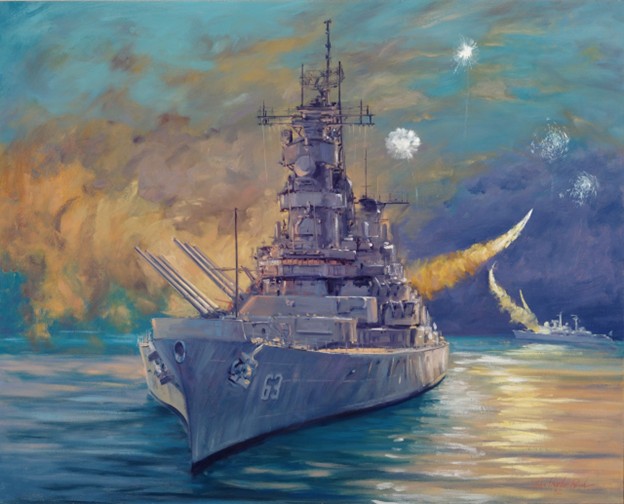
On
February 28th, 1991, a ceasefire went into effect. Saddam’s Army was a shadow of its former
self, Kuwait was liberated, and anyone who doubted America’s military might was
well instructed on the consequences of taking on the United States in open,
conventional battle. Potential future
adversaries took note. During the
campaign both battleships fired a total of 1,078 16-inch shells and launched 52
Tomahawks.[10] The many sorties flown by the 2 RQ-2
detachments of VC-6 played a critical role in assuring the 1,000+ shells were
as precise as possible and that every shot counted whether that be shore
bombardment against targets of opportunity or critical calls for fire against
Iraqi units in close contact with coalition troops. The total contribution of the airborne
drone-gun line team must also take partial credit for the fix of 10 Iraqi
Divisions dedicated to defending a geographic area well outside the coalition center
of gravity and disabled potential Iraqi reserves to be placed in an
advantageous position to stall any coalition advance. This is significant as Saddam dedicated 52 of
his 60 available divisions to the defense of Kuwait.
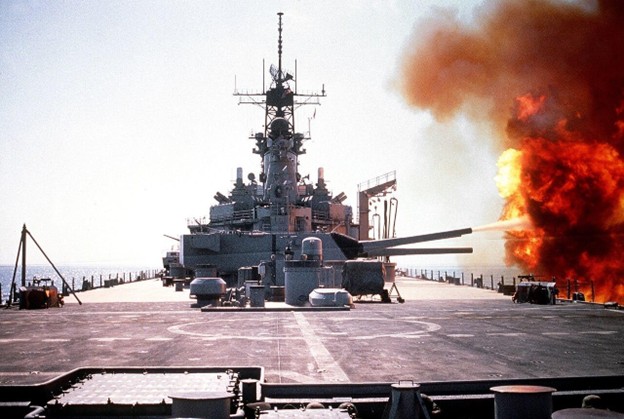
Vice
Admiral Stan Arthur (USN) highlighted the importance of the RQ-2s of Desert
Storm in the pages of the U.S. Naval Institute’s Proceedings magazine
stating, “Remotely piloted vehicles proved to be marvelous, versatile devices.
They allowed the battleships to attack the enemy on their own, without the need
for outside assistance in spotting. Spotting by the RPVs not only allowed for
accurate naval gunfire support but also provided instant battle damage
assessment. The RPV offers quick response and flexibility, because it is under
positive tactical control and has the ability to get below a low ceiling.”[11]
In
the official VC-6 history published in an official memorandum after the war,
the squadron commander, E.C. Ferriter reflects,
VC-6
Pioneer UAV8s played a crucial role in support of battleship combat operations
throughout operations DESERT SHIELD and DESERT STORM. VC-6 Detachment ONE
deployed with the battleship USS WISCONSIN (BB-64) and Detachment TWO deployed
with USS MISSOURI (BB-63). The UAV’s unique capabilities were exceptionally
valuable in reconnaissance and gunfire support operations. Pioneer’s infrared
camera proved particularly adept at locating enemy contacts of interest. Manned
and supported at a level intended to support only one surveillance flight every
other day, VC-6 UAV detachments flew three to four flights daily and provided
extensive coverage for Battle Group Commanders, NAVCENT and USCENTCOM. UAV’s
detected Silkworm ASM sites, AAA batteries, artillery, ammunition bunkers,
patrol boats, radar facilities, tank battalions, logistics sites and command
posts. Real-time imagery provided by VC-6 was directly responsible for the
pinpoint accuracy of 1,224 rounds of sixteen-inch gunfire directed at enemy
positions in southeastern Kuwait. An on-station UAV over Faylakah
Island linked video imagery of Iraqi soldiers waving white flags, recording the
first ever surrender of enemy forces to an unmanned vehicle. This imagery was
one of the Navy’s best war media events. It was shown on worldwide TV, and
frames were printed throughout the international press…During 1991, VC-6 was
transformed from a service organization to a vital operational combat unit. In
the Persian Gulf, VC-6 played an indispensable role in the Allied success in
Operation DESERT STORM and verified the importance of the UAV in any foreseeable
conflict. Squadron accomplishments were briefed to the highest levels of DOD
including the Secretary of Defense and received world acclaim through
international media coverage. At home, VC-6 met all commitments despite the
large number of assets and personnel deployed to DESERT STORM. BQM sorties, for
example, increased 17 percent over CY 1990. Through disciplined professionalism
and a commitment to performance, the "Firebees"
thrived during the most challenging period of squadron history. VC-6 excelled
under all conditions.[12]
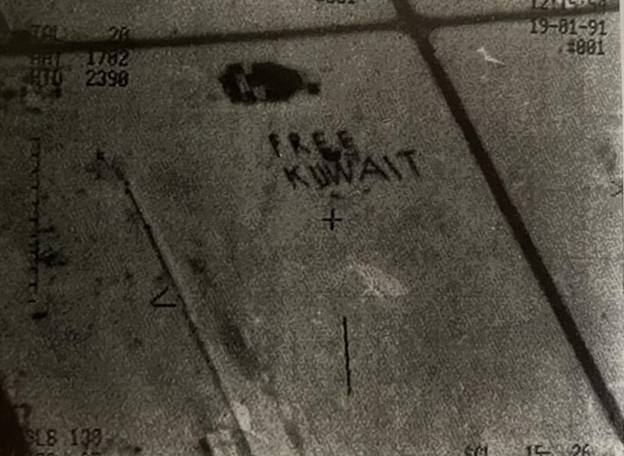
Throwing
the enemy out of position and off balance is the name of the game for special
operations. To create dilemmas for the
enemy and place doubts and unknowns which affect the distributions of their
units. Real time battle damage
assessments (BDA) and real time precision fire corrections are some of the most
important tools a commander can use to attempt to rapidly achieve political
objectives using air power. Unmanned systems that can assist in long range
fires getting “on target” or confirming a target has been sufficiently
destroyed are vital to accomplishing objectives or measuring
effectiveness.
The
RQ-2s flying off Missouri and Wisconsin may at first glance seem
like tactical level platforms which hold little strategic effect upon a large
campaign like Desert Storm, but this perception could not be more wrong. There are times when tactical units and their
extraordinary actions combine to achieve strategic level effects. The story of America’s battleships in Desert
Storm is an uncommon one and the story of their ship-borne drones are even more
unsung. The RQ-2’s contribution to the
advancement and development of unmanned combat aerial vehicles (UCAVs) is
instrumental in leading to what we see on battlefields all over the world. From the sands of the Middle East and Fields
of Eastern Europe to the Caucasus, drones have changed the character of warfare
and sparked a revolution in military affairs (RMA). This latest RMA has prompted many commands
across the U.S. Department of Defense, like U.S. Special Operations Command
(USSOCOM) to adapt to the evolution in the character of warfare.
USSOCOM’s
(United States Special Operations Command) “SOF Renaissance” outlines the
intent stated by the Commander, General Bryan Fenton, and many key aspects to
Special Operations goals to meet contemporary threats. The pamphlet states,
Today,
SOF finds itself in a similar position to the 1940s, facing great power
competition complexities. The increased coordination between China, Russia,
Iran, and North Korea demands a strategic response. SOF’s legacy of irregular
warfare and strategic competition is deeply ingrained in its DNA. As we
navigate this new era, the lessons of the past 80 years remind us that SOF’s
ability to adapt and innovate remains its greatest strength. This SOF
Renaissance demands that we continue to lead, innovate, and excel as a bridge
for strengthening and defending our nation. The nation’s main effort will
always be USSOCOM’s main effort…The National Defense Strategy (NDS) threats are
attempting to reshape the international order by posing significant challenges
to global security and stability. Combined with a rapidly changing character of
war, their convergence – a fusion of foes – is creating volatility and
uncertainty as never before. This is challenging the rules-based order in place
since World War II. PRC and Russia’s alignment on authoritarianism, coupled
with their strategic partnership, undermines efforts to maintain the
rules-based international system…In addition to these converging threats and
their employment of all levers of national power, the fluid future of warfare
is also in motion. Driven by technological, geopolitical, and societal changes,
the world is becoming more complex. With ubiquitous technical surveillance, a
pervasive system of data collection enables targeting on people, activities, and
locations utilizing various technologies such as online tracking, financial
transactions, and mobile devices. Understanding the distinction between the
evolving nature of war and its evolving character is essential for SOF to
maintain its place as a pathfinder for DoD, as we have trailblazed for decades.[13]

Case
studies such as the pioneering use of drones from battleships in the Gulf War
showcase what is possible when tactical innovations can produce strategic
dilemmas for the enemy. The threat of
amphibious assaults on Kuwait’s Gulf coast through the effectiveness of
battleship naval gunfire prompted Saddam’s generals to divert forces away from
the coalition main line of advance.
Normally a job reserved for SOF, successfully diverting large numbers of
enemy conventional forces away from the main effort is one of many unique
functions of SOF air power. Even if such
principles are executed by an unlikely group operating from the decks of
battleships, professionals should take notice of applications in operations
today.
As
SOCOM searches for meaning within a new post-GWOT (Global War on Terror) era of
great power competition, such case studies should serve as a motivator to seek
innovative methods by specialized air warfare practitioners. Using unmanned aerial vehicles to find and
fix the enemy is not a novelty. Throughout the GWOT and post-GWOT counter
terrorism phases we find ourselves in, RPAs have sought out and hunted down
enemy terror organizations and their leaders.
With SOF at the forefront of these operations, it is vital to maintain a
sense of how our tactics, technology, and personnel need to adapt to new enemy
capabilities. As we move to an era in
which non-state actors grow in weapons capabilities, we must continue to drive
innovation to retain the edge against them on the battlefield. Militias and rebel/terrorist organizations
such as Hezbollah, Kata’ib Hezbollah, Ansar Allah,
Al-Qaeda affiliates, and ISIS continue to wield more and more conventional
weapons within a “GWOT-like” environment.
Employing one way attack drones, anti-ship ballistic missiles, cruise
missiles, surface to air missiles, and many more, these groups seek to evolve
into a “hybrid-conventional” status beyond the typical IED or AK-47.
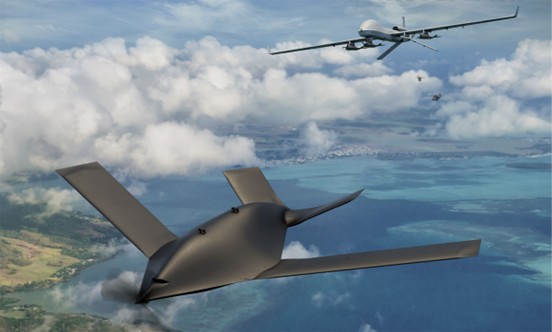
If
we are to maintain our military superiority over these types of organizations
while still building a force capable of taking on Great Power rivals, we must
harness the operational and tactical lessons of our own operational experiences
in areas like Syria, Iraq, and Yemen as well as the series of conflicts across
the globe since 2020. Building a myriad
of unmanned systems across the joint force, able to perform a multitude of
mission sets in both post GWOT hybrid conventional environments as well as the
“big one”, will allow SOF and the regular forces the ability to adapt and
overcome threats as they appear.
Ultimately the goal should be to provide the combatant commander with a
buffet of tactical platforms across all domains of war offering low risk
solutions to friendly forces and maximizing the ability to outmaneuver enemy
adaptations on the modern battlefield.
Small platforms such as the RPV providing a WWII era naval gunfire
platform real time target corrections from above go a long way in inspiring the
sorts of systems we must have to find, fix, and finish the enemy at a
distance. The RPV alone certainly did
not win the war, no one tactical system ever does win a war alone. The joint nature of success on the modern
battlefield requires a myriad of such systems to shape victory from the tactical
and operational levels, eventually achieving strategic success. Our ability to leverage history and seek the
knowledge therein prepares our force to adapt to the threats we will face
tomorrow.
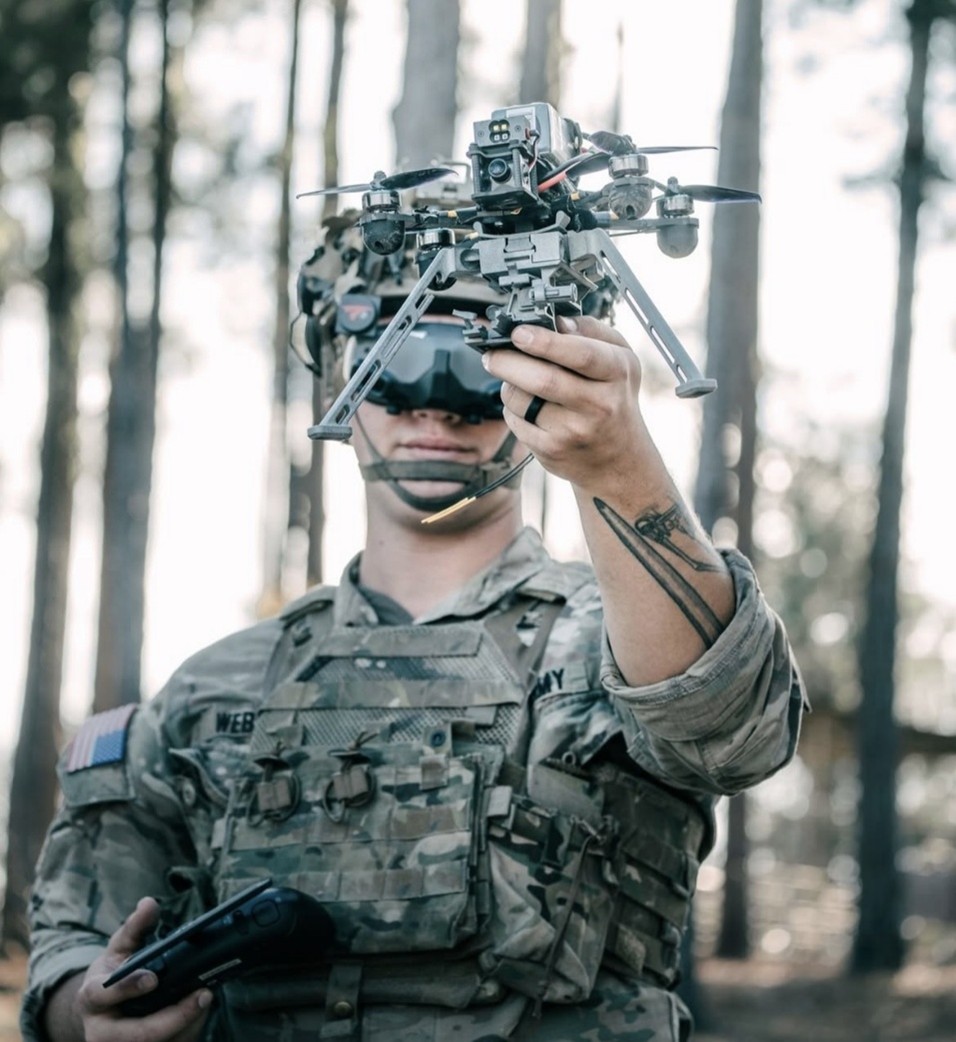 Figure 11: Soldier of the 75th Ranger
Regiment with sUAS
Figure 11: Soldier of the 75th Ranger
Regiment with sUAS Disclaimer:
The views and opinions expressed in this article are
those of the author and do not necessarily represent the views or opinions of
the United States Government, Department of Defense, or Department of the Air
Force.
Author Bio:
Captain Willis is an AFSOC Pilot and fellow with the
Consortium of Indo-Pacific Researchers.
He is a distinguished graduate of the University of Cincinnati’s Air
Force ROTC program with a BA in international affairs and a minor in political
science. His work has appeared in Proceedings,
Naval History, Air University’s Journal of Indo-Pacific Affairs, Air
University’s Wild Blue Yonder Journal,
Air Commando Journal, and elsewhere.
Sources
Consulted:
Westermeyer, Paul W.
“Liberating Kuwait U.S. Marines in the Gulf War, 1990-1991.”
https://www.usmcu.edu/, 2014.
https://www.govinfo.gov/app/details/GOVPUB-D214-PURL-gpo52758.
Willis, Grant. “Israel’s Firebees:
UAVs & the Future of the Suppression of Enemy Air Defenses.” Consortium of
Indo-Pacific Researchers -, August 29, 2022.
https://indopacificresearchers.org/iaffirebees/.
Combat Ships. Combat Ships Gulf War Warriors S3 E4, 2022.
Bauernfeind, Ingo. U.S.
battleships 1939-45. Havertown, PA: Casemate Publishers, 2024.
Burr, Lawrence, and
Peter Bull. US Fast Battleships 1938-91 The Iowa Class. Oxford, UK:
Osprey, 2010.
“SOF Renaissance.”
https://www.socom.mil/, February 2025.
https://www.socom.mil/Documents/2025-SOF_Renaissance(25FEB)Web.pdf.
Arthur, Stan. “The Storm at Sea.” U.S. Naval
Institute, February 21, 2019. https://www.usni.org/magazines/proceedings/1991/may/storm-sea.
Ferriter, E.C. “Fleet Composite Squadron 6 History for
Calendar Year 1991.”, April 2,
1992.https://www.history.navy.mil/content/dam/nhhc/research/archives/command-operation-reports/aviation-squadron-command-operation-reports/vc/vc-6/pdf/1991.pdf.
[1] Westermeyer, Paul W. “Liberating Kuwait U.S. Marines in the Gulf War,
1990-1991.” https://www.usmcu.edu/, 2014.
https://www.govinfo.gov/app/details/GOVPUB-D214-PURL-gpo52758. Pg 21-24.
[2] Willis, Grant. “Israel’s Firebees: UAVs &
the Future of the Suppression of Enemy Air Defenses.” Consortium of
Indo-Pacific Researchers -, August 29, 2022.
https://indopacificresearchers.org/iaffirebees/.
[3] Combat Ships. Combat Ships Gulf War Warriors S3 E4, 2022.
[4] Bauernfeind, Ingo. U.S. battleships 1939-45. Havertown, PA:
Casemate Publishers, 2024. Pg 213.
[5] Bauernfeind, Ingo. U.S. battleships 1939-45. Havertown, PA:
Casemate Publishers, 2024. Pg 215-225.
[6] Burr, Lawrence, and Peter Bull. US
Fast Battleships 1938-91 The Iowa Class. Oxford, UK: Osprey, 2010. Pg 42.
[7] Ibid., Pg
44.
[8] Ibid., Pg
44.
[9] Ibid., Pg
44.
[10] Ibid., Pg
44.
[11] Arthur, Stan. “The Storm at
Sea.” U.S. Naval Institute, February 21, 2019.
https://www.usni.org/magazines/proceedings/1991/may/storm-sea.
[12] Ferriter, E.C. “Fleet
Composite Squadron 6 History for Calendar Year 1991.”
https://www.history.navy.mil/, April 2, 1992. https://www.history.navy.mil/.
Pg 9-10.
[13] “SOF Renaissance.”
https://www.socom.mil/, February 2025.
https://www.socom.mil/Documents/2025-SOF_Renaissance(25FEB)Web.pdf. Pg 5-7.